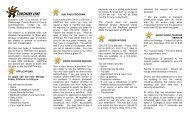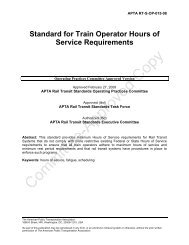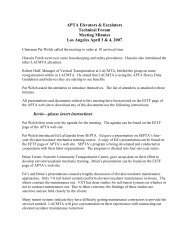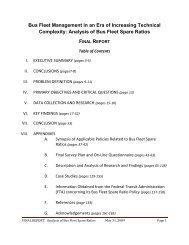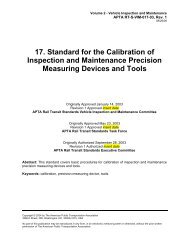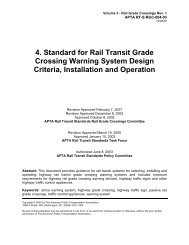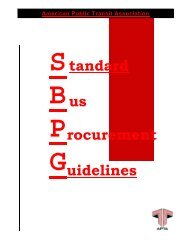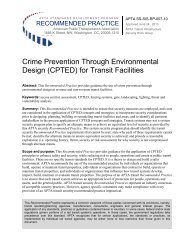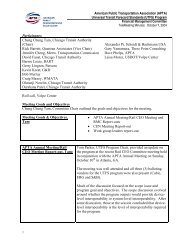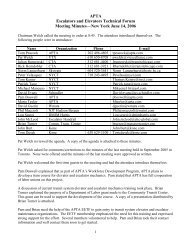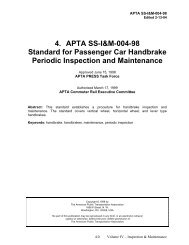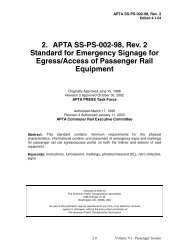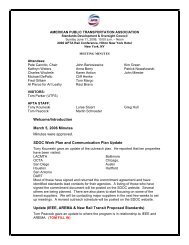4. APTA SS-PS-004-99, Rev. 1 Standard for Low-Location Exit Path ...
4. APTA SS-PS-004-99, Rev. 1 Standard for Low-Location Exit Path ...
4. APTA SS-PS-004-99, Rev. 1 Standard for Low-Location Exit Path ...
You also want an ePaper? Increase the reach of your titles
YUMPU automatically turns print PDFs into web optimized ePapers that Google loves.
<strong>APTA</strong> <strong>SS</strong>-<strong>PS</strong>-<strong>004</strong>-<strong>99</strong>, <strong>Rev</strong>. 1<br />
Edited 4-1-04<br />
3.1.17 photoluminescent (PL): Having the property of emitting light that continues <strong>for</strong><br />
a length of time after excitation by visible or invisible light has been removed (i.e., selfilluminating.)<br />
3.1.18 primary exit: The normal (preferred) exit point of passengers and crewmembers<br />
from the affected car in an emergency to an adjacent car located at either end of the<br />
affected car.<br />
3.2 Abbreviations and acronyms<br />
CFR Code of Federal Regulations<br />
DIN Deutsche Industrie Norm<br />
EL electroluminescent<br />
ERC equivalency review committee<br />
FAA Federal Aviation Administration<br />
HPPL high per<strong>for</strong>mance photoluminescent material<br />
IMO International Marine Organization<br />
LED light-emitting diode<br />
LLEPM low-location exit path marking<br />
PL photoluminescent<br />
PRE<strong>SS</strong> Passenger Rail Equipment Safety <strong>Standard</strong>s<br />
<strong>4.</strong> General system requirements<br />
The LLEPM system must provide evacuation guidance <strong>for</strong> passengers and crewmembers<br />
when normal and emergency sources of illumination are obscured or inoperative. It must<br />
be active, or become active, immediately and automatically upon loss of normal and<br />
emergency lighting power. <strong>Low</strong>-location markings must be visible within a volume as<br />
defined in Section 3.1.10. The system must enable passengers to visually identify the<br />
escape path to all primary exits in at least two directions. In cars with only one available<br />
primary exit (e.g., when end doors are locked or secured), additional measures shall be<br />
taken to direct passengers to an alternative door exit or provide emergency door opening<br />
instructions <strong>for</strong> the secured primary exit.<br />
The low-location marking system shall be composed of three elements:<br />
– <strong>Exit</strong> path marking materials/fixtures<br />
– <strong>Exit</strong> door marking materials<br />
– <strong>Exit</strong> door signage marking materials/fixtures<br />
The LLEPM system must be independent of the rail car’s normal and emergency lighting<br />
systems and must become immediately visible when the car’s normal and emergency<br />
electrical power ceases to operate. This system shall clearly outline the path to the rail<br />
car’s primary exits, which shall be marked in accordance with <strong>APTA</strong> <strong>SS</strong>-<strong>PS</strong>-002-98, <strong>Rev</strong>.<br />
2, <strong>Standard</strong> <strong>for</strong> Emergency Signage <strong>for</strong> Egress/Access of Rail Passenger Equipment.<br />
LLEPM system requirements are as follows:<br />
<strong>4.</strong>8<br />
Volume VI - Passenger System



